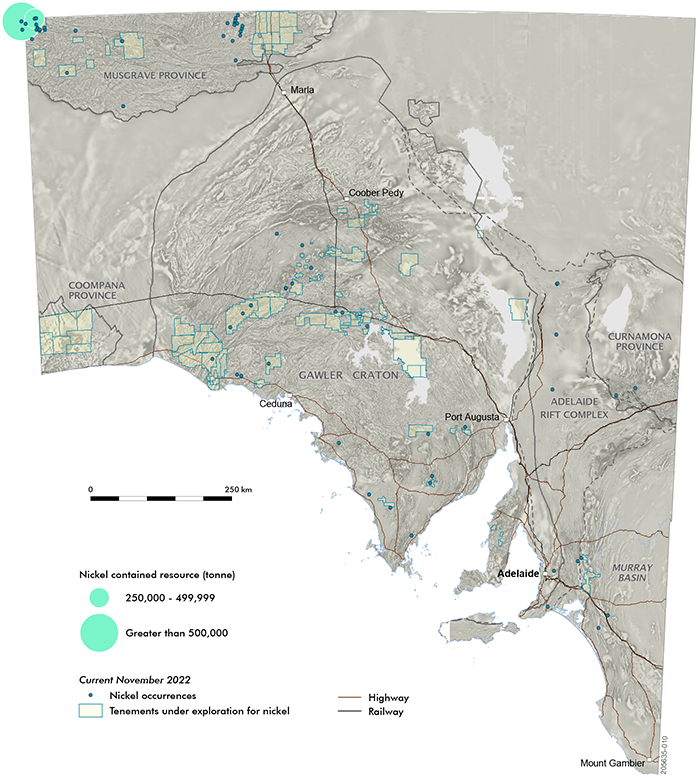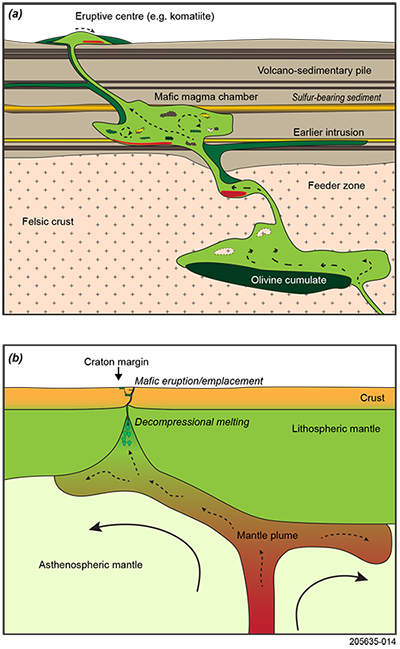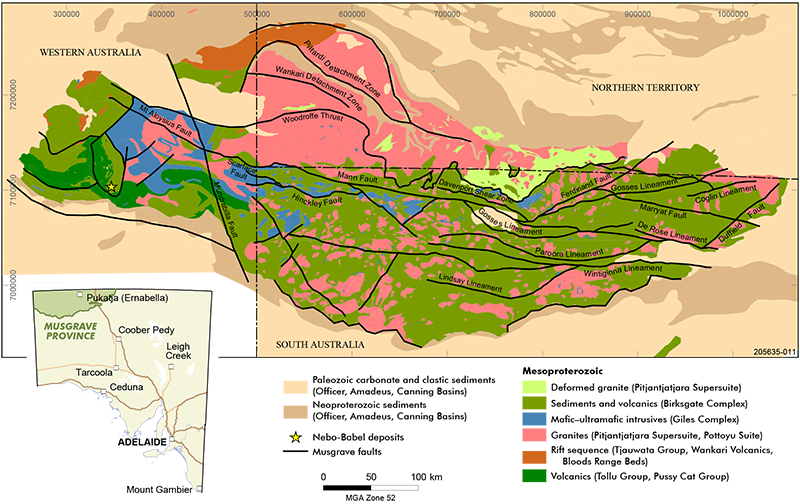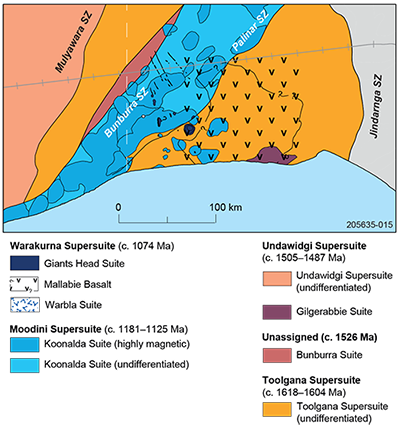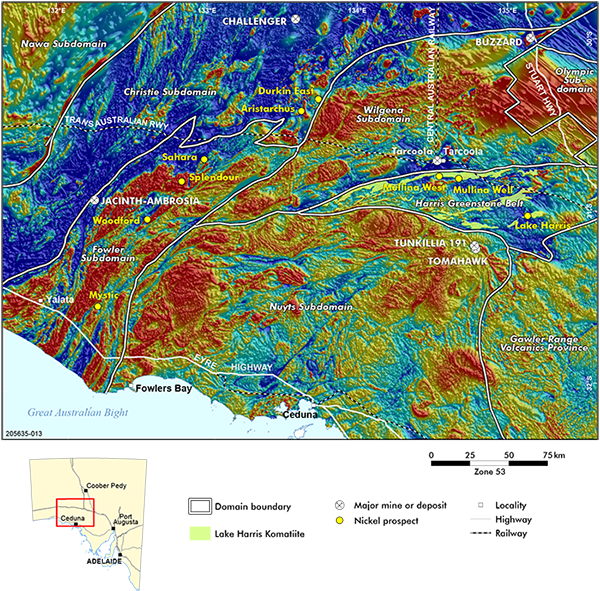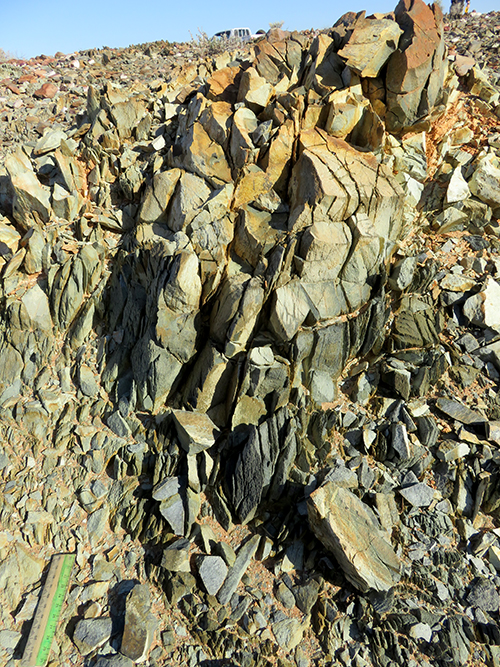Anthony Reid and Mitchell Bockmann
Geological Survey of South Australia, Department for Energy and Mining
Anthony.Reid@sa.gov.au
Download this article as a PDF (4 MB); cite as MESA Journal 97, pages 10–20
Published December 2022
Introduction
Surging demand for nickel reflects the supply pressures as the global economy transitions to low carbon energy technologies such as wind turbines and electric vehicles (International Energy Agency 2021). Australia supplies around one quarter of world nickel production, with over 90% of this derived from deposits in Western Australia (Teh and Pheeney 2021). Of the Western Australian nickel deposits, Archean komatiite-hosted deposits in the Eastern Goldfields Province of the Yilgarn Craton are by far the most economically significant.
Nickel deposits are typically orthomagmatic mineral systems in which massive sulfides accumulate from deep-sourced ultramafic and mafic magmas (Barnes et al. 2016; Barnes et al. 2017). Nickel is rarely the only commodity present within these deposits, with most containing other metals including copper, cobalt, vanadium and the platinum group elements (PGE). Secondary processes such as deformation, hydrothermal processes or deep weathering (laterite) may also play a role in impacting the economics of a given deposit (e.g. Hoatson et al. 2006; Blanks et al. 2022). Importantly, many nickel orebodies are relatively small but extremely high grade, often being tabular in shape and located within magmatic host rocks (Barnes and Robertson 2019). As a result, nickel deposits can be difficult to find, and exploration targeting in greenfield regions requires persistence. But the application of a mineral systems approach and careful appraisal of pre-existing data can enhance the chances of success (Barnes et al. 2016).
The purpose of this article is to provide a brief review of the nickel potential of South Australian geological provinces. South Australia currently hosts no economically significant nickel deposits. This lack of deposits is a reflection of differences in geology between Western Australia and South Australia, but also in part reflects previous exploration focus, with relatively few dedicated nickel exploration companies taking up tenements in South Australia (Fig. 1). However, some aspects of South Australia’s geology are prospective for nickel deposits and future exploration success is a reasonable expectation, provided time and resources can be dedicated to greenfield exploration. Recent technical success by Western Areas, now IGO, in the western Gawler Craton in particular, is a flagship example of the dedication required to unlock the nickel potential of South Australia (see review of recent work in Department for Energy and Mining 2021).
Figure 1 Map of South Australia showing black and white total magnetic intensity image, current exploration tenements which have indicated nickel as a target commodity, and the location of entries in the MinDep mineral deposit database which indicate the presence of nickel.
Magmatic nickel deposits
Magmatic nickel deposits are typically associated with either komatiitic or tholeiitic magmas and may form in eruptive lava flows, or within layered intrusive bodies (e.g. Naldrett 2004; Arndt et al. 2005; Barnes 2006; Barnes et al. 2017). Nickel sulfide accumulation from asthenospheric mantle-derived magmas reflects the interplay between the magma’s primary metal and sulfur content, and processes of assimilation and fractional crystallisation during magma ascent and emplacement in the crust (e.g. Luolavirta et al. 2018). For example, a magma that is highly metal-enriched but lacks sufficient sulfur will not crystallise sulfide, rather metal ions will be preferentially sequestered into silicate minerals. However, given sufficient sulfur, such as can be provided by an external sulfur source (e.g. sulfidic country rock), chalcophile metal ions can be scavenged during formation of an immiscible sulfide liquid. The concentration of these sulfide droplets into an ore body requires physical segregation from the silicate magma and accumulation in trap sites that can be influenced by the geometry of the lava flow or magmatic intrusion (Fig. 2a).
Lithospheric architecture is a key factor in the formation of nickel sulfide orebodies (Begg et al. 2010; Begg et al. 2018). Asthenospheric mantle upwelling is typically a result of mantle plumes which rise, decompress and undergo partial melting (Fig. 2b). Mantle melts can be focused along major lithospheric-scale boundaries and regions where significant topographic changes at the base of the lithosphere occur. For example, an upwelling plume that impinges on the roots of a craton that extends into the asthenosphere will facilitate buoyant flow towards the craton margins, where the lithosphere–asthenosphere boundary is shallower. Likewise, focusing of these melts along trans-lithospheric structures can enable the transport of hot mantle melt upwards into the geochemically enriched subcontinental lithospheric mantle and also the relatively sulfur-rich crust. However, the geochemical implications of the interaction between the asthenospheric mantle source region and the subcontinental lithospheric mantle is of variable significance (Arndt 2013; Blanks et al. 2020). The forcing of large volumes of mantle melt into the crust is facilitated by active regional tectonism, with deposits most commonly forming in mildly compressional to transpressional tectonic settings (e.g. Begg et al. 2010; Blanks et al. 2022).
Figure 2 Schematic diagrams showing key processes involved in forming nickel sulfide deposits. (a) Crustal view of mafic magma chamber processes, transport zones and potential eruptive successions. Note the formation of nickel sulfide orebody is shown as occurring within the feeder, or magma transfer zone, within magma chambers undergoing active assimilation of sulfur-bearing country rock, and in the eruption and turbulent flow associated with komatiitic volcanics. Diagram modified after Luolavirta et al. (2018). (b) Lithospheric-scale view of an ascending mantle plume impinging onto the subcontinental lithospheric mantle leading to the flow of mantle material towards discontinuities such as afforded by a craton margin or paleocraton margin. The focusing of the mantle plume into this shallower zone promotes decompression melting and the infiltration of mantle melt into the lithosphere and eventually the crust, where mineralisation can occur. Diagram modified after Begg et al. (2010).
South Australian nickel prospectivity
Here we will provide a brief review of the geology of South Australia’s nickel prospectivity by focusing on:
- mafic intrusions of the Musgrave and Coompana provinces
- mafic intrusions of the Gawler Craton, particularly the western Gawler Craton
- late Archean komatiite of the central and southern Gawler Craton.
The MinDep database for South Australian economic geology provides a comprehensive listing of all deposits, prospects and occurrences with nickel as a commodity (access via the South Australian Resources Information Gateway, SARIG). Figure 1 shows these listings with respect to the main geological terranes of South Australia. Appendix 1 provides a summary of those listings and Appendix 2 provides a list of all documentation within the associated SAMRef geoscience publications database related to nickel sulfide mineralisation across South Australia. Importantly, in this brief review we consider only the above types of geology in any detail. The MinDep database does provide evidence for mafic rock related nickel sulfide potential in other locations, for example, in the Delamerian Orogen associated with mafic bodies such as the Black Hill Norite (e.g. Mortimer 2006). In addition, Havilah Resources Ltd was recently granted Accelerated Discovery Initiative (ADI) funding from the South Australian Government to undertake exploration drilling on a possible mafic–ultramafic intrusive complex in the central Curnamona Province in eastern South Australia, exploring for nickel among other commodities. It is also important to recognise that the regions discussed below are also prospective for other commodities, including gold, copper and related critical minerals; however, these aspects are not discussed in any detail here.
Mafic intrusions of the Musgrave and Coompana provinces
In the Musgrave Province of central Australia, a series of mafic and ultramafic igneous intrusions are prospective for nickel mineralisation and related commodities (Gum and Katona 2010). These intrusions are collectively known as the Giles Complex and formed at c. 1090–1040 Ma as part of the Warakurna Large Igneous Province (LIP) (Fig. 3; Wingate et al. 2004; Maier et al. 2015). The basement to the Warakurna LIP varies across the province, but includes Paleoproterozoic to Mesoproterozoic metasedimentary and meta-igneous units such as the Birksgate Complex and the Pitjanjatjarra Supersuite (Major and Conor 1993; Glikson et al. 1995; Edgoose et al. 2004; Wade et al. 2006; Wade et al. 2008; Howard et al. 2015). These basement units underwent high temperature to ultra-high temperature metamorphism and deformation during the Musgrave Orogeny, over the period c. 1200–1100 Ma (Edgoose et al. 2004; Wade et al. 2008; Smithies et al. 2011).
Figure 3 Lithostratigraphic basement geology interpretation of the Musgrave Province with Giles Complex intrusions shown in blue.
Mafic intrusions of the Giles Complex host Ni–Cu–PGE mineralisation in the western Musgrave Province, with the best example being the Nebo-Babel deposits. The Nebo-Babel deposits are 2 spatially separate deposits around 1.5 km apart, with a combined indicated and inferred resource of 390 Mt at 0.31% Ni, 0.34% Cu, and Au, Ag, Co, Pd and Pt credits (OZ Minerals 2020). The deposits are currently undergoing feasibility studies and related work. Host mafic intrusions in the deposits were derived from a tholeiitic parent magma with ~8–9% MgO and sourced from relatively shallow depths (80 km) that underwent varying degrees of crustal assimilation and crystal fractionation at depths of 10–12 km (Seat et al. 2011). Significantly, the most crustally contaminated portions of the intrusion assimilated the local, relatively sulfur-poor felsic orthogneiss. Sulfide mineralisation occurred as a result of magma mixing between crustally contaminated magmas, and relatively low-titanium basaltic magmas, as well as more primitive high- titanium basaltic magmas (Godel et al. 2011). There is a strong structural control on the formation of the deposit, being a chonolith in form, and located in a magma feeder zone which enabled fluxing of the accumulating immiscible sulfide with successive silicate magma batches (Seat et al. 2007; Lightfoot and Evans-Lamswood 2015).
The mafic intrusions of the Warakurna LIP have been interpreted to have resulted from mantle plume activity (Wingate et al. 2004). However, subsequent recognition of the relatively long duration (~50 Myr) of mafic magmatism across the Musgrave Province together with the relatively shallow melting depths for the source magmas (~80 km) have led to proposals that plate tectonic activity played a role, in particular extension due to far-field stresses from distant orogenic events (Evins et al. 2010a; Evins et al. 2010b; Maier et al. 2014; Maier et al. 2015). In general, the Musgrave Province lies at the junction between the 3 main tectonic elements of Archean–Proterozoic Australia, being adjacent to the Yilgarn and broader Western Australian Craton, the Gawler Craton in the south and the North Australian Craton in the north. The mafic upwelling that formed the Giles Complex fits with the notion that mantle upwelling that is focused toward the edges of cratonic blocks is an important ingredient in the formation of nickel sulfide mineral systems (Begg et al. 2010; Begg et al. 2018).
The South Australian portion of the Giles Complex contains a range of mafic–ultramafic intrusive bodies and a set of related contemporaneous dolerite intrusions, the Alcurra Dolerite (Woodhouse and Gum 2003; Constable et al. 2005; Maier et al. 2015). There are numerous mafic intrusions in South Australia, located in Aṉangu Pitjantjatjara Yankunytjatjara Lands, and are visible on aeromagnetic imagery (e.g. Rankin and Newton 2002). These intrusions have been shown to have assimilated up to 10% of local felsic crust and formed from primitive, yet relatively shallow asthenospheric parent melts (Wade 2006). The similarity in process suggests these intrusions underwent similar assimilation and fractional crystallisation processes to those documented from Nebo-Babel deposits, which highlights the mineral potential of these intrusive bodies. Exploration for these deposits requires locating the feeder zones to the magma chambers, or related structural trap site, and typically relies on geophysical and geochemical characterisation of the bodies (Constable et al. 2005; Gum and Katona 2010).
Coompana Province – broader extent of the Giles Complex
The Coompana Province in southwestern South Australia has recently undergone a significant amount of new geological study, culminating in a Geological Survey of South Australia (GSSA) drilling program that has tested some of the main geophysical domains in the region (Dutch et al. 2018). Although the entire province is buried beneath a veneer of Neoproterozoic to Holocene sediment, recent drilling has demonstrated that the large magnetic features of the region can be linked to the Giants Head Suite of the Giles Complex. Drillhole CDP002 was cited on a circular, strongly remanently magnetised feature, about 11 km in diameter, and which overlaps the southeastern quadrant of the large, deeper Coompana Magnetic Anomaly (Fig. 4). The olivine dolerite in CDP002 was emplaced at 1074 ± 6 Ma (Jagodzinski et al. 2019b), which indicates this intrusion and by inference the series of similar magnetic features across the region, are part of the Warakurna LIP (Wise et al. 2018; Pawley et al. 2020).
Figure 4 Interpreted crystalline basement map of the Coompana Province highlighting the location of Giants Head Suite mafic intrusions, equivalent in age to the Giles Complex intrusions of the Musgrave Province. Map after Wise et al. (2018) and Pawley et al. (2021).
Mafic rocks of this event in the Coompana Province range from relatively primitive to evolved and fractionated compositions. The most primitive rocks are isotopically juvenile, consistent with a juvenile mantle source. By contrast, the more fractionated rocks have distinctly more evolved Nd isotopic signatures and incompatible trace element patterns that are both reflective of crustal contamination (Dutch 2018). Significant volumes of mafic magma are likely to have intruded in large plutonic bodies across the Coompana Province at this time, and similar prospectivity models could be applied to those intrusions as are relevant for the Musgrave Province.
Mafic intrusions of the western Gawler Craton
The western Gawler Craton has been an area of interest for nickel exploration since a Department for Mines and Energy drilling program revealed mafic and ultramafic rocks in the region, including gabbros and altered chromite-bearing olivine-rich ultramafics (Daly and Martin 1989; Daly and van der Stelt 1992; Daly et al. 1994; Morris et al. 1994). Two regions are considered of particular interest, the Fowler Domain and eastern Christie Domain (Fig. 5).
Figure 5 Total magnetic intensity image of the central-western Gawler Craton showing the location of the major geophysical domains discussed in this paper – the Fowler and Christie domains and the Harris Greenstone Belt. Also shown are the locations of selected mines, mineral deposits and mineral prospects from the MinDep database. The komatiitic volcanic sequences of the Harris Greenstone Belt are shown in light green highlight over the magnetic high sequences of the central Gawler Craton region.
The Fowler Domain lies on the southwestern edge of the Gawler Craton and is notable for the degree of intensive structural reworking in the region, visible on aeromagnetic images as a series of anastomosing shear zones (Teasdale 1997; Daly et al. 1998; Stewart and Betts 2010). These shear zones extend to the Moho and lithospheric mantle and are potential conduits for mafic and ultramafic magmas (Thiel and Heinson 2010). The region contains relatively few basement exposures, with Cenozoic sediment and Holocene sand dunes dominating the surface geology. However, 2 broad zones of lithostratigraphy have been recognised in the basement of the Fowler Domain (Reid 2019):
- a western region dominated by reworked c. 1690–1670 Ma intrusives of the Tunkillia Suite, metasedimentary rocks formed at or around this time (Howard et al. 2008; Howard et al. 2011), and an older, Archean–Paleoproterozoic basement of the Mulgathing Complex
- an eastern region dominated by c. 1620 Ma intrusives of the St Peter Suite interlayered with c. 1580 Ma Hiltaba Suite granitoids (Jagodzinski et al. 2019a).
The metamorphic grade across the Fowler Domain is relatively high, with peak granulite facies conditions (~8 kbar at 800 °C) occurring at c. 1710–1690 Ma in the western region and similar peak conditions occurring at c. 1580 Ma in parts of the eastern Fowler Domain (Reid et al. 2019). However, we note that metamorphic studies have only been carried out on high metamorphic grade rocks, and many of the drillholes across the region contain metagranite rather than migmatitic gneiss (e.g. Morris et al. 1994). This suggests there is variation in the metamorphic grade experienced during the different tectonic events that have affected the Fowler Domain.
Mafic intrusions are known in both the western and eastern regions of the Fowler Domain (Daly and Martin 1989; Daly et al. 1994), although the timing of these intrusions are currently unconstrained by geochronology. Nevertheless, mineral exploration in this region has been largely focused on the intrusions of the western Fowler Domain. At the Sahara prospect (Fig. 5), disseminated and massive Ni–Cu sulfides are present within metagabbro and pyroxenite intrusive bodies (Western Areas 2020). The extent of the mineralisation at Sahara prospect, and other related prospects in the region, including Firefly, Meridith, Mystic and Splendour, is the subject of active exploration (IGO Limited 2022).
In the eastern Christie Domain lie a series of Archean – earliest-Paleoproterozoic rocks known as the Mulgathing Complex, which contain metapyroxenite, metagabbro and metagabbronorite intrusions (Aristarchus Metaperidotite; Burden Metagabbro; see Williams and Reid 2021). Nickel mineralisation in the Aristarchus Metaperidotite is magmatic in origin and occurs as disseminated, interstitial sulfides including pentlandite and violarite (<1880 ppm Ni, <10 ppb Au, <38 ppb Pt; Daly and van der Stelt 1992; McKinnon-Matthews 2007). The peridotite also contains chromite, ilmenite and magnetite. The host peridotite has no precise age constraints but is younger than c. 2475 Ma and is only weakly foliated (Jagodzinski et al. 2009). Pyroxenite at Blackfellow Hill also contains accessory sulfide and elevated nickel and chromium contents (<880 ppm Ni, <2750 ppm Cr, <18 ppb Au; Daly and van der Stelt 1992).
The nickel potential of these intrusions remains poorly understood. There are certainly multiple generations of mafic intrusions in the area, with the metapyroxenite intrusions having the most primitive geochemistry and highest nickel contents (e.g. drill core DMDD-002; McKinnon-Matthews et al. 2007; Jagodzinski et al. 2009). Mafic rocks in this region are associated with magnetite gneiss (interpreted as iron formation) and metacarbonates, which are sulfidic and could provide an external sulfur source for mafic intrusions in the region. Questions remain as to whether the volume of mafic rocks necessary for the formation of large nickel sulfide systems are present in the region, but further work is underway on these mafic intrusions as part of the GSSA GP2: next generation mineral systems mapping project. This project will include new geochemical, isotopic, geochronological, geophysical and petrophysical characterisation that will enhance our understanding of the mafic magmatic systems of the western Gawler Craton.
Komatiite-hosted deposits
Komatiite and high-magnesium basaltic rocks occur in the central and southern Gawler Craton, with the best-known set of these ultramafic units being within the Harris Greenstone Belt (Fig. 5; Daly et al. 1998; Teale et al. 2000; Davies 2003). The Harris Greenstone Belt contains 3 subparallel belts of high magnetic intensity that have been shown to contain komatiitic volcanic rocks that have been intensively folded and sheared. The metavolcanic rocks in the region are virtually entirely covered by Cenozoic sediment, with only one outcrop known on the shore of Lake Harris (Fig. 6). Komatiites and high- magnesium basalts of the Harris Greenstone Belt formed at c. 2520 Ma and are part of the older units within the Mulgathing Complex (Hoatson et al. 2005; Swain et al. 2005). Metavolcanic rocks in the region are typically schistose and intensely chloritic, reflecting deformation intensity and relatively low metamorphic grade. This region has had some exploration for Ni–Cu–PGE deposits (e.g. McKinnon-Matthews and Thompson 2006); however, no economic mineralisation has been discovered thus far.
Figure 6 Lake Harris Komatiite in outcrop on the shore of Lake Harris. (Photo 418739)
In the Mullina Well area, drilling by the GSSA in 2001 and 2002 intersected supergene nickel enrichment associated with ultramafic bodies (Davies 2002; Davies 2003). The drilling also demonstrated examples of spinifex texture and adcumulate olivine within komatiitic volcanic rocks and confirmed the sequence of metavolcanics is associated with lesser intervals of metasediment (including iron formation) and felsic volcanics (Davies 2002). At Mullina Well, the metabasalt- and metakomatiite-bearing sequence has an estimated width of ~300 m (Davies 2003).
The Lake Harris sequence comprises high- to low- magnesium komatiite and tholeiitic basalt, with MgO ranging from 16 to 43% (Hoatson et al. 2005). The Lake Harris Komatiite in the Lake Harris region has negligible nickel depletion associated with fractionation, but indicates a strong olivine control in a dominantly sulfur undersaturated magma. The komatiite has low sulfur (100–600 ppm) and high Pd + Pt (5–30 ppb) contents, and is typical of aluminium-depleted komatiite similar to those known from other Archean terranes (Hoatson et al. 2005). A key feature that is needed to be established in future exploration is the presence of sulfur saturation and hence depletion of nickel. The Harris Greenstone Belt contains over 300 km strike length of komatiitic volcanics and hence the potential for a range of physical and chemical conditions during formation of the komatiitic volcanics mean that further exploration is warranted across the region.
Discussion and future work
Each of the regions discussed here have unique geological challenges for mineral discovery. In the case of the Giles Complex, regional geophysical data, in particular gravity but also electromagnetic data, could be significantly improved to better define the limits of the mafic bodies and their internal geometry, with particular emphasis on finding feeder zones and conduits (Gum and Katona 2010). Many of the significant mafic intrusions are in regions of outcrop or subcrop, and careful geochemical sampling of these will yield further insights into prospectivity, for example, by enabling delineation of zones of sulfur saturation.
In the Fowler Domain, the timing of magmatic intrusion is poorly known as the majority of the geochronology completed thus far has focused on felsic rocks of the region (discussed by Reid 2019). Once the timing of the mafic intrusions is defined, then other elements of the broader mineral system can be better established including tectonic setting and lithospheric architecture at the time of intrusion.
Detailed mapping of the crystalline basement geology in this complexly deformed region is difficult and time-consuming, particularly with the persistent veneer of sediment that obscures the basement geology. However, the South Australian Discovery Mapping (SADM) project aims to deliver new and improved datasets that will greatly improve structural interpretations in regions such as the western Gawler Craton, and provide data that will be compatible with machine learning approaches to exploration. Refining the basement geology maps for the Fowler Domain will likely yield a high reward in defining the location of mafic intrusions similar in texture and geometry to those that host the known massive sulfide mineralisation at Sahara prospect for example. Further integration of the significant downhole geochemistry and lithology data collected in recent mineral exploration across the region (e.g. Lockheed et al. 2017) will assist with detailed geological mapping in the region.
In the Harris Greenstone Belt, a significant opportunity exists to further test the geochemistry and fertility of the komatiitic volcanics, with improved geophysical data including gravity, as well as targeted drilling campaigns. Given the ~300 km strike length, further sampling of the volcanics and associated rock types to identify the presence of sulfur-bearing metasedimentary rocks in association with the komatiites would be highly beneficial.
In all of the geological domains identified here, continued best practice in community engagement, in particular with Aboriginal traditional owners of Aṉangu Pitjantjatjara Yankunytjatjara, the Far West Coast Aboriginal Corporation, Antakirinja Matu-Yankunytjatjara Aboriginal Corporation, and other traditional owner groups in the region of the Gawler Craton, will be an important part of the exploration process.
Conclusion
This review has aimed to briefly review the geology of the 3 major geological regions in South Australia that are prospective for nickel sulfide mineralisation. Mesoproterozoic intrusions in the Musgrave Province are known to contain Ni–Cu–PGE mineralisation in Western Australia and could well host similar mineralisation in the South Australia portion of the province. Rocks of similar age are also known in the Coompana Province and although no evidence for sulfide mineralisation is available from the limited drilling in this region, in principle, mafic magmatism of similar composition and tectonic setting could be present in this region.
In the Gawler Craton, mafic intrusions of the Fowler Domain and eastern Christie Domain have been shown to host massive nickel sulfide mineralisation – albeit at subeconomic levels at present – and exploration is continuing in the region. The late Archean Harris Greenstone Belt in the central Gawler Craton is also a region of interest for nickel sulfide mineralisation. Drilling in the early 2000s was successful in delineating the presence of komatiite volcanics in the Harris Greenstone Belt and in age-equivalent rocks on the Eyre Peninsula (Teale et al. 2000; Davies 2003; Teale 2006). However, the apparent sulfur undersaturation of the ultramafic units intersected in the Harris Greenstone Belt has limited their perceived prospectivity. Further drilling to test the ~300 km strike length of these magnetically distinct units could provide the impetus for further discovery in the region.
Appendix 1
Summary of all deposits, prospects and occurrences with nickel as a commodity in the MinDep mineral deposits database.
Download Appendix 1 (XLSX, 32.4 KB)
Appendix 2
List of all documentation within the SAMRef geoscience publications database related to nickel sulfide mineralisation.
Download Appendix 2 (XLSX, 92.4 KB)
Acknowledgements
Bruno Rescignano (Department for Energy and Mining, DEM) provided a search of the SAMRef database that assisted production of this brief review. Jess Bonsell (DEM) assisted with drafting of figures. Megan Williams, Tom Wise and Claire Wade (GSSA) are thanked for helpful reviews.
References
Arndt N 2013. The lithospheric mantle plays no active role in the formation of orthomagmatic ore deposits. Economic Geology 108:1953–1970. doi:10.2113/econgeo.108.8.1953.
Arndt NT, Lesher CM and Czamanske GK 2005. Mantle-derived magmas and magmatic Ni-Cu-(PGE) deposits. In Hedenquist JW, Thompson JFH, Goldfarb RJ and Richards JP eds, Economic Geology 100th anniversary volume. Society of Economic Geologists, pp 5–24.
Barnes SJ 2006. Komatiite-hosted nickel sulfide deposits: geology, geochemistry, and genesis. In Barnes SJ, Nickel deposits of the Yilgarn Craton: geology, geochemistry, and geophysics applied to exploration. Society of Economic Geologists. doi:10.5382/SP.13.03.
Barnes SJ, Cruden AR, Arndt N and Saumur BM 2016. The mineral system approach applied to magmatic Ni–Cu–PGE sulfide deposits. Ore Geology Reviews 76:296–316. doi:10.1016/j.oregeorev.2015.06.012.
Barnes SJ, Holwell DA and Le Vaillant M 2017. Magmatic sulfide ore deposits. Elements 13:89–95. doi:10.2113/gselements.13.2.89.
Begg GC, Hronsky JAM, Arndt NC, Griffin WL, O’Reilly SY and Hayward N 2010. Lithospheric, cratonic, and geodynamic setting of Ni-Cu-PGE sulfide deposits. Economic Geology 105:1057–1070. doi:10.2113/econgeo.105.6.1057.
Begg GC, Hronsky JMA, Griffin WL and O’Reilly SY 2018. Chapter 1 - Global- to deposit-scale controls on orthomagmatic Ni-Cu(-PGE) and PGE reef ore formation. In Mondal SK and Griffin WL eds, Processes and ore deposits of ultramafic-mafic magmas through space and time. Elsevier, pp 1–46. doi:10.1016/B978-0-12-811159-8.00002-0.
Blanks DE, Holwell DA, Barnes SJ, Schoneveld LE, Fiorentini ML, Baublys KA, Mbiri L and Knott TR 2022. Mobilization and fractionation of magmatic sulfide: emplacement and deformation of the Munali Ni-(Cu-platinum group element) deposit, Zambia. Economic Geology. doi:10.5382/econgeo.4906.
Daly SJ, Fanning CM and Fairclough MC 1998. Tectonic evolution and exploration potential of the Gawler Craton, South Australia. AGSO Journal of Australian Geology and Geophysics 17:145–168.
Edgoose C, Scrigemour I and Close D 2004. Geology of the Musgrave Block, Northern Territory, Report 15. Northern Territory Geological Survey. Darwin.
Evins PM, Smithies RH, Howard HM, Kirkland CL, Wingate MTD and Bodorkos S 2010a. Devil in the detail; The 1150–1000 Ma magmatic and structural evolution of the Ngaanyatjarra Rift, west Musgrave Province, Central Australia. Precambrian Research 183:572–588. doi:10.1016/j.precamres.2010.02.011.
Evins PM, Smithies RH, Howard HM, Kirkland CL, Wingate MTD and Bodorkos S 2010b. Redefining the Giles Event within the setting of the 1120-1020 Ma Ngannyatjarra Rift, west Musgrave Province, central Australia, Record 2010/6. Geological Survey of Western Australia, Perth.
Glikson AY, Ballhaus CG, Clarke GL, Sheraton JW, Stewart AJ and Sun SS 1995. Geological framework and crustal evolution of the Giles mafic-ultramafic complex and environs, western Musgrave Block, central Australia. AGSO Journal of Australian Geology and Geophysics 16:41–67.
Godel B, Seat Z, Maier WD and Barnes S-J 2011. The Nebo-Babel Ni-Cu-PGE sulfide deposit (west Musgrave Block, Australia): Pt 2, Constraints on parental magma and processes, with implications for mineral exploration. Economic Geology 106(4):557–584. doi:10.2113/econgeo.106.4.557.
Hoatson DM, Jaireth S and Jaques AL 2006. Nickel sulfide deposits in Australia: characteristics, resources, and potential. Ore Geology Reviews 29:177–241. doi:10.1016/j.oregeorev.2006.05.002.
Hoatson DM, Sun S-S, Duggan MB, Davies MB, Daly SJ and Purvis AC 2005. Late Archaean Lake Harris Komatiite, central Gawler Craton, South Australia: geologic setting and geochemistry. Economic Geology 100:349–374. doi:10.2113/gsecongeo.100.2.349.
Howard HM, Smithies RH, Kirkland CL, Kelsey DE, Aitken A, Wingate MTD, Quentin de Gromard R, Spaggiari CV and Maier WD 2015. The burning heart — The Proterozoic geology and geological evolution of the west Musgrave Region, central Australia. Gondwana Research 27:64–94. doi:10.1016/j.gr.2014.09.001.
Howard KE, Hand M, Barovich KM, Payne JL and Belousova EA 2011. U-Pb, Lu-Hf and Sm-Nd isotopic constraints on provenance and depositional timing of metasedimentary rocks in the western Gawler Craton: implications for Proterozoic reconstruction models. Precambrian Research 184:43–62. doi:10.1016/j.precamres.2010.10.002.
IGO Limited 2022. Western Gawler Project. IGO Limited website, accessed 26 August 2022.
Luolavirta K, Hanski E, Maier W, Lahaye Y, O’Brien H and Santaguida F 2018. In situ strontium and sulfur isotope investigation of the Ni-Cu-(PGE) sulfide ore-bearing Kevitsa intrusion, northern Finland. Mineralium Deposita 53:1019–1038. doi:10.1007/s00126-018-0792-6.
Maier WD, Howard HM, Smithies RH, Yang S, Barnes S-J, O’Brien H, Huhma H and Gardoll S 2014. Mafic-ultramafic intrusions of the Giles Event, Western Australia: petrogenesis and prospectivity for magmatic ore deposits, Report 134. Geological Survey of Western Australia, Perth.
Maier WD, Howard HM, Smithies RH, Yang SH, Barnes SJ, O'Brien H, Huhma H and Gardoll S 2015. Magmatic ore deposits in mafic–ultramafic intrusions of the Giles Event, Western Australia. Ore Geology Reviews 71:405–436. Doi:10.1016/j.oregeorev.2015.06.010.
Naldrett AJ 2004. Magmatic sulfide deposits. Springer-Verlag, Berlin, Germany. doi:10.1007/978-3-662-08444-1.
OZ Minerals 2020. Resources & Reserves. OZ Minerals website, accessed 22 August 2022.
Reid AJ, Halpin JA and Dutch RA 2019. Timing and style of high-temperature metamorphism across the western Gawler Craton during the Paleo- to Mesoproterozoic. Australian Journal of Earth Sciences 66(8):1085-1111. doi:10.1080/08120099.2019.1602565.
Seat Z, Beresford S, Grguric B, Waugh R, Hronsky JA, Gee MAM, Groves D and Mathison C 2007. Architecture and emplacement of the Nebo–Babel gabbronorite-hosted magmatic Ni–Cu–PGE sulfide deposit, West Musgrave, Western Australia. Mineralium Deposita 42:551–581. doi:10.1007/s00126-007-0123-9.
Seat Z, Mary Gee MA, Grguric BA, Beresford SW and Grassineau NV 2011. The Nebo-Babel Ni-Cu-PGE sulfide deposit (West Musgrave, Australia): Pt. 1. U/Pb zircon ages, whole-rock and mineral chemistry, and O-Sr-Nd isotope compositions of the intrusion, with constraints on petrogenesis. Economic Geology 106(4):527–556. doi:10.2113/econgeo.106.4.527.
Stewart JR and Betts PG 2010. Implications for Proterozoic plate margin evolution from geophysical analysis and crustal-scale modeling within the western Gawler Craton, Australia. Tectonophysics 483(1–2):151–77. doi:10.1016/j.tecto.2009.11.016.
Swain G, Woodhouse A, Hand M, Barovich K, Schwarz M and Fanning CM 2005. Provenance and tectonic development of the late Archaean Gawler Craton, Australia; U-Pb zircon, geochemical and Sm-Nd isotopic implications. Precambrian Research 141(3–4):106–136. doi:10.1016/j.precamres.2005.08.004.
Teasdale J 1997. Methods for understanding poorly exposed terranes: the interpretive geology and tectonothermal evolution of the western Gawler Craton. Unpublished PhD thesis, the University of Adelaide.
Wade BP 2006. Unravelling the tectonic framework of the Musgrave Province, Central Australia. PhD thesis, the University of Adelaide.
Wade BP, Barovich KM, Hand M, Scrimgeour IR and Close DF 2006. Evidence for early Mesoproterozoic arc-related magmatism in the Musgrave Block, central Australia: implications for Proterozoic crustal growth and tectonic reconstructions of Australia. Journal of Geology 114(1):43–63. doi:10.1086/498099.
Wade BP, Kelsey DE, Hand M and Barovich KM 2008. The Musgrave Province: stitching north, west and south Australia. Precambrian Research 166(1–4):370–386. doi:10.1016/j.precamres.2007.05.007.
Western Areas Ltd 2020. Annual report [PDF 8.6 MB]. ASX Limited website, accessed 26 August 2022.
Wingate MTD, Pirajno F and Morris PA 2004. Warakurna large igneous province; a new Mesoproterozoic large igneous province in west-central Australia. Geology 32(2):105–108. doi:10.1130/G20171.1.


